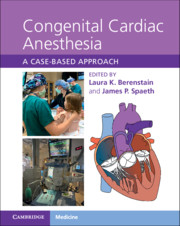Book contents
- Congenital Cardiac Anesthesia
- Congenital Cardiac Anesthesia
- Copyright page
- Dedication
- Contents
- Contributors
- Introduction
- Chapter 1 A Congenital Heart Disease Primer
- Section 1 Left-to-Right Shunts
- Chapter 2 Ventricular Septal Defect
- Chapter 3 Double-Outlet Right Ventricle
- Chapter 4 Transitional Atrioventricular Septal Defect
- Chapter 5 Unbalanced Atrioventricular Septal Defect
- Section 2 Right-Sided Obstructive Lesions
- Section 3 Left-Sided Obstructive Lesions
- Section 4 Complex Mixing Lesions
- Section 5 Single-Ventricle Physiology
- Section 6 Heart Failure, Mechanical Circulatory Support, and Transplantation
- Section 7 Miscellaneous Lesions and Syndromes
- Index
- References
Chapter 4 - Transitional Atrioventricular Septal Defect
from Section 1 - Left-to-Right Shunts
Published online by Cambridge University Press: 09 September 2021
- Congenital Cardiac Anesthesia
- Congenital Cardiac Anesthesia
- Copyright page
- Dedication
- Contents
- Contributors
- Introduction
- Chapter 1 A Congenital Heart Disease Primer
- Section 1 Left-to-Right Shunts
- Chapter 2 Ventricular Septal Defect
- Chapter 3 Double-Outlet Right Ventricle
- Chapter 4 Transitional Atrioventricular Septal Defect
- Chapter 5 Unbalanced Atrioventricular Septal Defect
- Section 2 Right-Sided Obstructive Lesions
- Section 3 Left-Sided Obstructive Lesions
- Section 4 Complex Mixing Lesions
- Section 5 Single-Ventricle Physiology
- Section 6 Heart Failure, Mechanical Circulatory Support, and Transplantation
- Section 7 Miscellaneous Lesions and Syndromes
- Index
- References
Summary
Atrioventricular septal defects are common congenital heart defects affecting the interatrial and interventricular septa as well as the atrioventricular valves. Atrioventricular septal defects occur due to the failure of endocardial cushions to properly develop and migrate to septate the heart during embryonic development; therefore they are also referred to as endocardial cushion defects. There are three common types or descriptions for atrioventricular septal defects: partial, transitional, and complete. An ostium primum type atrial septal defect exists in all types of atrioventricular septal defects. Partial and transitional atrioventricular septal defects have similar physiologic implications and are often diagnosed later in life as left-to-right shunting is not as significant; patients with complete atrioventricular septal defects have more significant left-to-right shunting with more severe pulmonary overcirculation, usually necessitating earlier intervention. This chapter discusses the pertinent findings and perioperative management of a patient with an unrepaired transitional atrioventricular septal defect.
Keywords
- Type
- Chapter
- Information
- Congenital Cardiac AnesthesiaA Case-based Approach, pp. 20 - 24Publisher: Cambridge University PressPrint publication year: 2021

